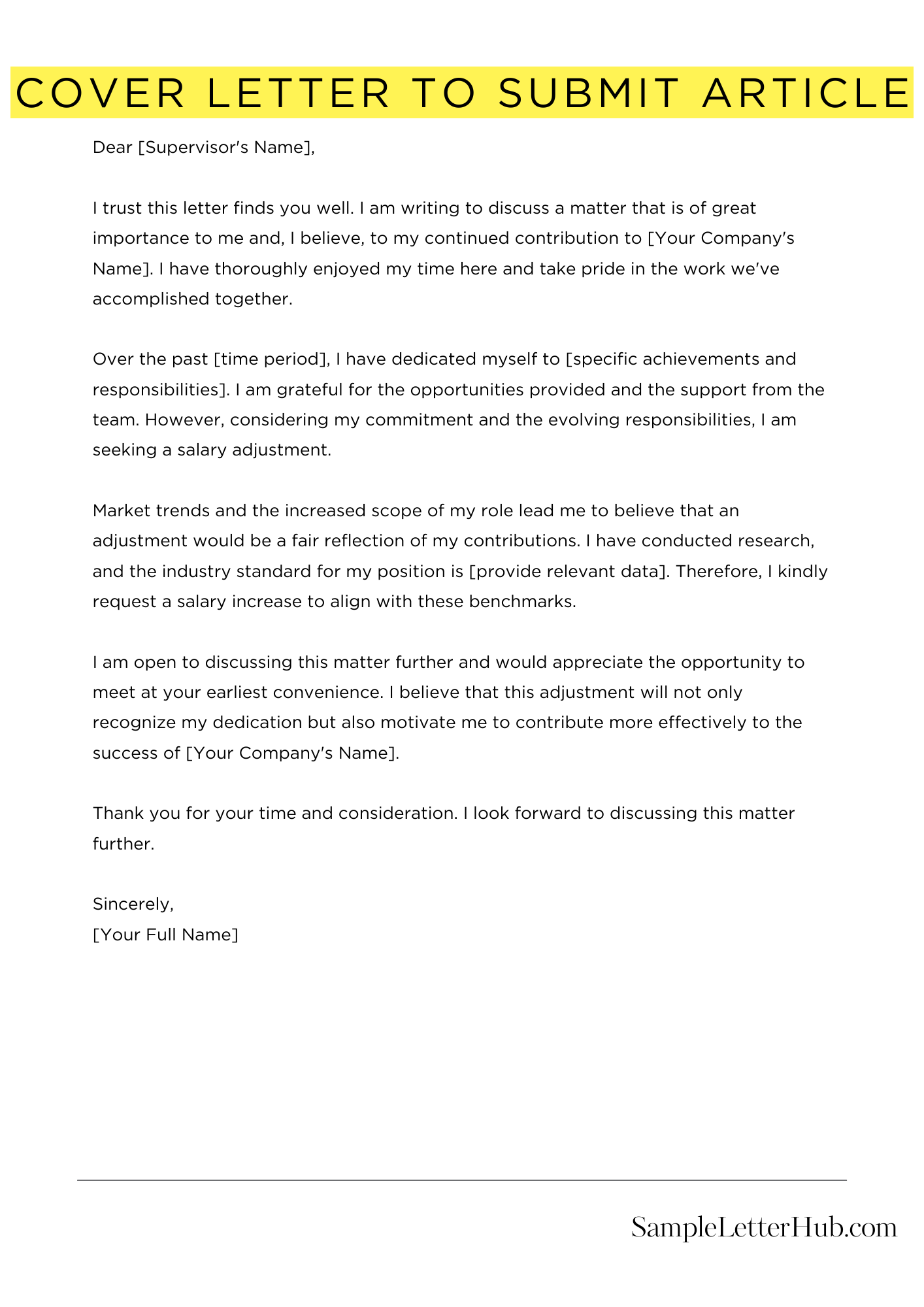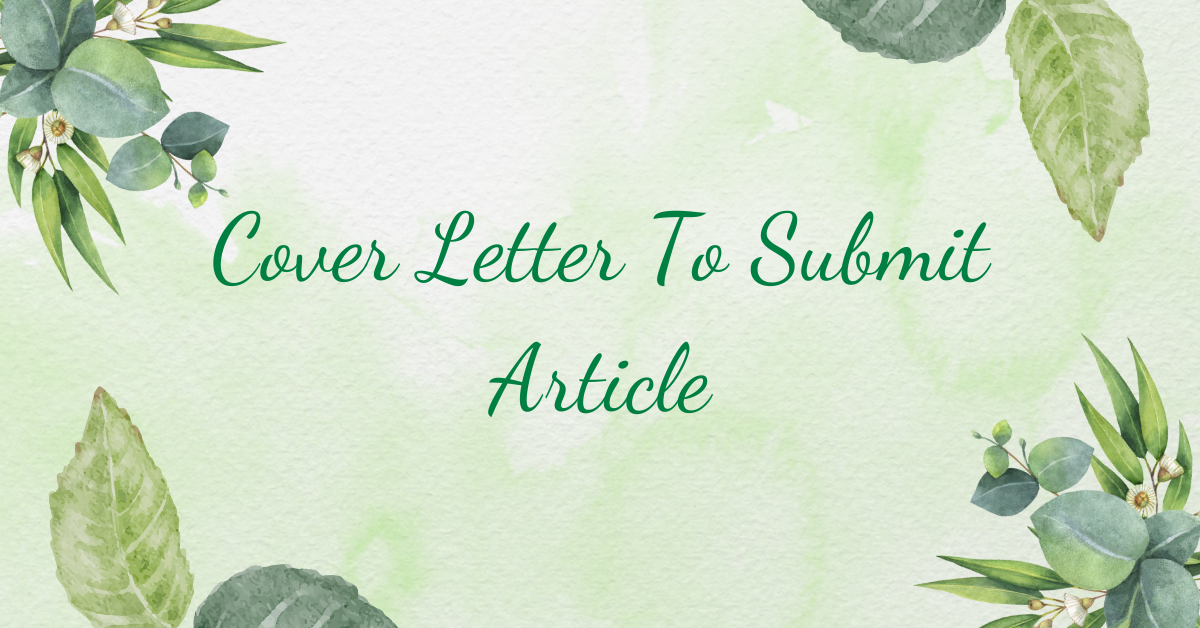A cover letter to submit an article is a document that you send to a magazine, newspaper, or other publication along with your article submission. The purpose of the cover letter is to introduce yourself and your article, and to convince the editor that your article is worth publishing.
In this article, we will share some templates, examples, and samples of cover letters to submit articles. These samples will help you to write a cover letter that will make your article stand out from the crowd.
We hope that these samples will be helpful to you. Please feel free to use them as a starting point for your own cover letter.

How to Write a Great Article
**Introduction**
Writing a great article is not as difficult as it may seem. By following a few simple steps, you can create an article that is informative, engaging, and well-written.
**Step 1: Choose a topic**
The first step is to choose a topic for your article. This is an important decision, as the topic will determine the content and tone of your article. When choosing a topic, there are a few things to keep in mind:
* **Your audience:** Who are you writing for? What are their interests?
* **Your purpose:** What do you want to achieve with your article? Do you want to inform, entertain, or persuade?
* **Your expertise:** What do you know about the topic? Are you qualified to write about it?
Once you have chosen a topic, you can start to gather information. This can be done through research, interviews, or personal experience.
**Step 2: Create an outline**
Once you have gathered your information, you can start to create an outline for your article. An outline will help you to organize your thoughts and ensure that your article flows smoothly.
Your outline should include the following elements:
* **Introduction:** This is where you will introduce your topic and state your main point.
* **Body:** This is where you will develop your main point and provide evidence to support it.
* **Conclusion:** This is where you will summarize your main points and restate your thesis statement.
**Step 3: Write your first draft**
Once you have created an outline, you can start to write your first draft. Don’t worry about making it perfect at this stage, just get your thoughts down on paper.
As you write, keep your audience in mind. Use language that they will understand and avoid jargon. You should also use strong verbs and vivid imagery to make your writing more engaging.
**Step 4: Revise and edit**
Once you have finished writing your first draft, take some time to revise and edit it. This is an important step in the writing process, as it will help you to improve the clarity, accuracy, and flow of your article.
When revising, look for any errors in grammar, spelling, or punctuation. You should also make sure that your article is well-organized and that your main points are clear and concise.
**Step 5: Get feedback**
Once you are satisfied with your revised draft, get feedback from others. This could be a friend, family member, or colleague. Ask them to read your article and give you their feedback on the clarity, accuracy, and flow.
**Step 6: Make final edits**
After you have received feedback, make any necessary final edits to your article. This could include making changes to the structure, content, or language.
**Conclusion**
Writing a great article takes time and effort, but it is a rewarding experience. By following these steps, you can create an article that is informative, engaging, and well-written.
How to Write a Cover Letter to Submit an Article
When submitting an article to a publication, it is important to include a cover letter. A cover letter is a one-page document that introduces you and your article, and explains why you think it would be a good fit for the publication.
1. Start with a strong opening paragraph
The first paragraph of your cover letter should grab the editor’s attention and make them want to read more. Start with a strong hook, such as a statistic, a quote, or a personal anecdote. Then, briefly introduce yourself and your article.
2. Highlight your qualifications
In the second paragraph, highlight your qualifications for writing the article. This could include your experience, your expertise, or your research. Be specific and provide evidence to support your claims.
3. Explain why your article is a good fit for the publication
In the third paragraph, explain why you think your article is a good fit for the publication. Consider the publication’s target audience, its editorial style, and its recent articles. Show the editor that you have done your research and that you understand the publication’s needs.
4. Use strong verbs
Throughout your cover letter, use strong verbs that convey action and confidence. Avoid using passive voice or weak verbs. Instead, use verbs that show that you are taking ownership of your work and that you are confident in your abilities.
5. Proofread carefully
Before you submit your cover letter, proofread it carefully for any errors in grammar, spelling, or punctuation. A well-written cover letter will make a good impression on the editor and increase your chances of getting your article published.
6. Keep it brief
Your cover letter should be no more than one page long. Editors are busy people, so they don’t have time to read long cover letters. Get to the point quickly and clearly, and make sure that your cover letter is easy to read.
7. Include your contact information
At the end of your cover letter, include your contact information so that the editor can reach you if they have any questions. Include your name, email address, phone number, and mailing address.
5 Frequently Asked Questions About Cover Letter To Article
1. What is a cover letter to the editor?
A cover letter to the editor is a letter that you write to the editor of a publication to introduce yourself and your article idea. It is an opportunity to make a strong case for why your article should be published in their publication.
2. What are the key elements of a cover letter to the editor?
The key elements of a cover letter to the editor include:
- Your name and contact information
- The name of the publication you are writing to
- The date
- A brief introduction of yourself and your qualifications
- A summary of your article idea
- A statement of why you believe your article would be a valuable addition to the publication
- A call to action
3. How long should a cover letter to the editor be?
A cover letter to the editor should be brief and to the point. Aim for no more than one page in length.
4. What is the best way to format a cover letter to the editor?
The best way to format a cover letter to the editor is to use a professional font and layout. Use single spacing and left-align your text. Include your name and contact information at the top of the letter, and the name of the publication and date at the top right. End the letter with a call to action, such as asking the editor to contact you to discuss your article idea further.
5. What are some tips for writing a strong cover letter to the editor?
Here are some tips for writing a strong cover letter to the editor:
- Do your research and make sure that your article idea is a good fit for the publication.
- Write a clear and concise summary of your article idea.
- Highlight your qualifications and experience that make you an expert on the topic.
- Be persuasive and make a strong case for why your article should be published.
- Proofread your letter carefully before sending it.

